Audit Report: Evidence Collection and Professional Scepticism Analysis
VerifiedAdded on 2020/02/03
|8
|2316
|55
Report
AI Summary
This report delves into the core principles of auditing, specifically examining the emphasis auditors place on gathering and accepting evidence in contrast to exercising professional scepticism. It begins by outlining the role of professional scepticism as defined in ISA 200, highlighting its importance in identifying potential fraud and material misstatements. The report then analyzes the practical limitations that often lead auditors to prioritize evidence collection, such as vouchers and bills, to assess the accuracy of financial figures. It explores the various sources of audit evidence, including internal and external sources, and discusses the methods used to gather and evaluate this evidence. Real-world examples, like the Tesco audit scandal, are used to illustrate the consequences of insufficient scepticism and the critical need for reliable evidence. The report concludes that while professional scepticism is crucial, the collection and analysis of sufficient, relevant, and valid evidence remains paramount for providing stakeholders with a fair and reliable view of financial data and for making informed decisions.
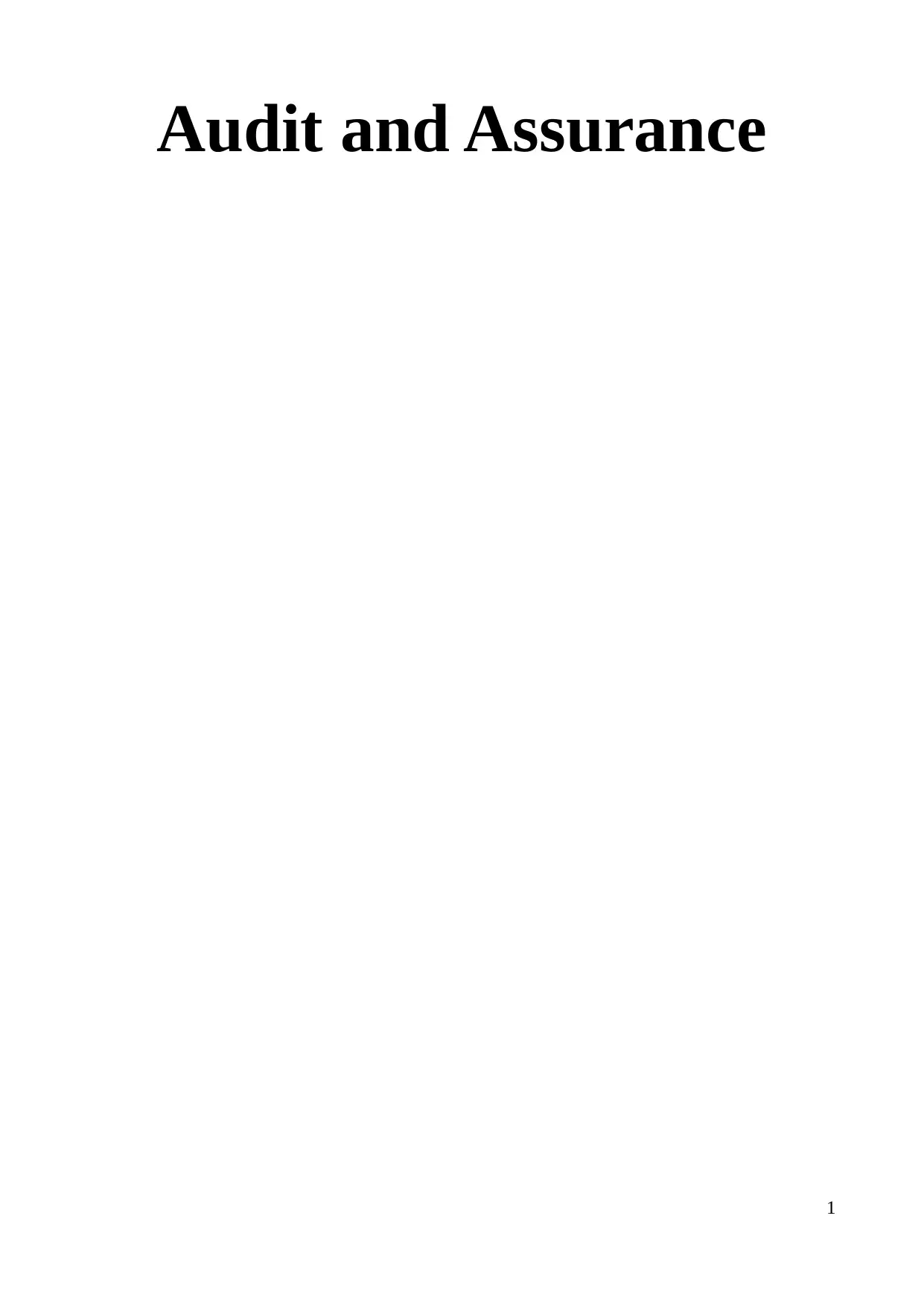
Audit and Assurance
1
1
Paraphrase This Document
Need a fresh take? Get an instant paraphrase of this document with our AI Paraphraser
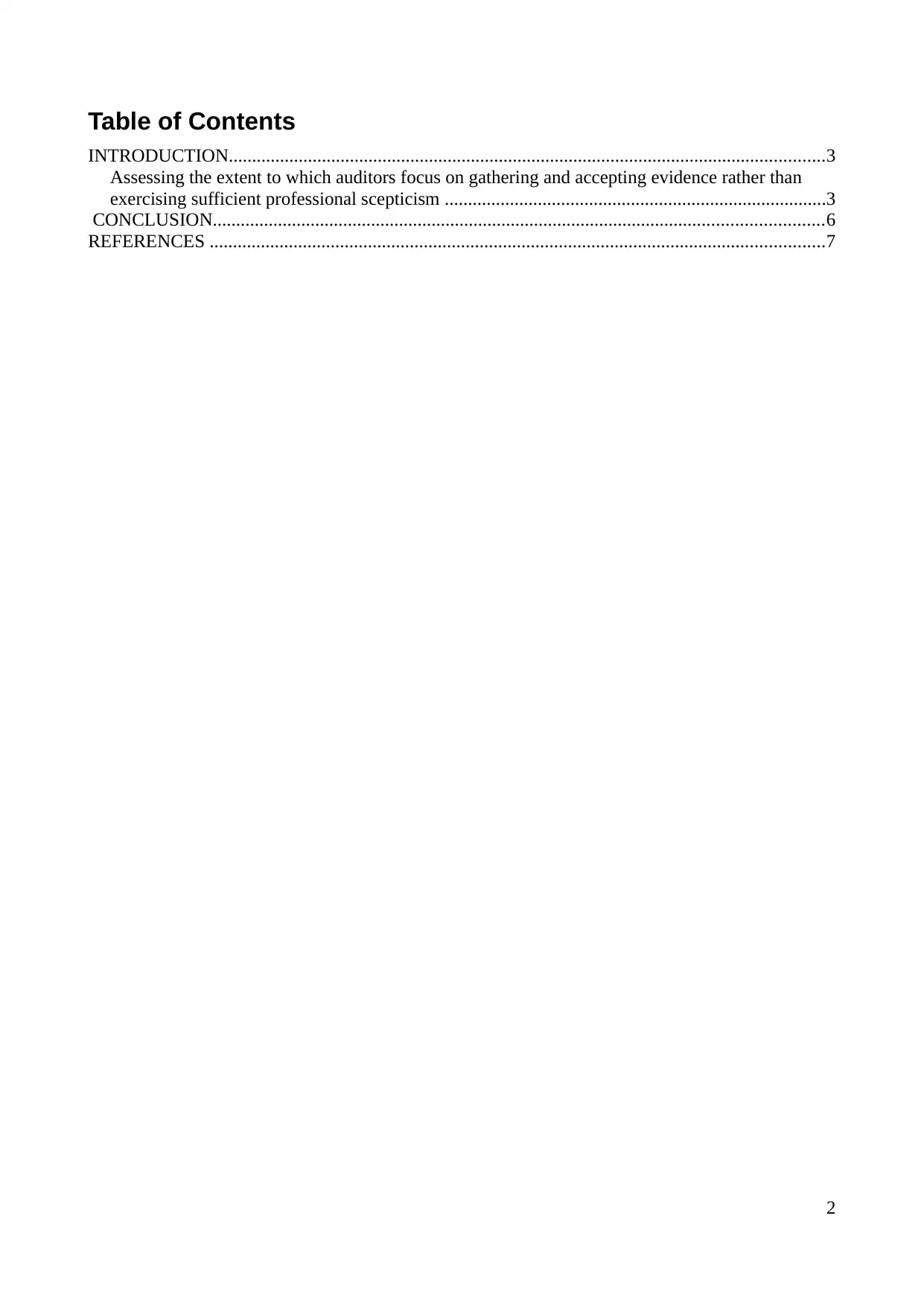
Table of Contents
INTRODUCTION................................................................................................................................3
Assessing the extent to which auditors focus on gathering and accepting evidence rather than
exercising sufficient professional scepticism ..................................................................................3
CONCLUSION...................................................................................................................................6
REFERENCES ....................................................................................................................................7
2
INTRODUCTION................................................................................................................................3
Assessing the extent to which auditors focus on gathering and accepting evidence rather than
exercising sufficient professional scepticism ..................................................................................3
CONCLUSION...................................................................................................................................6
REFERENCES ....................................................................................................................................7
2
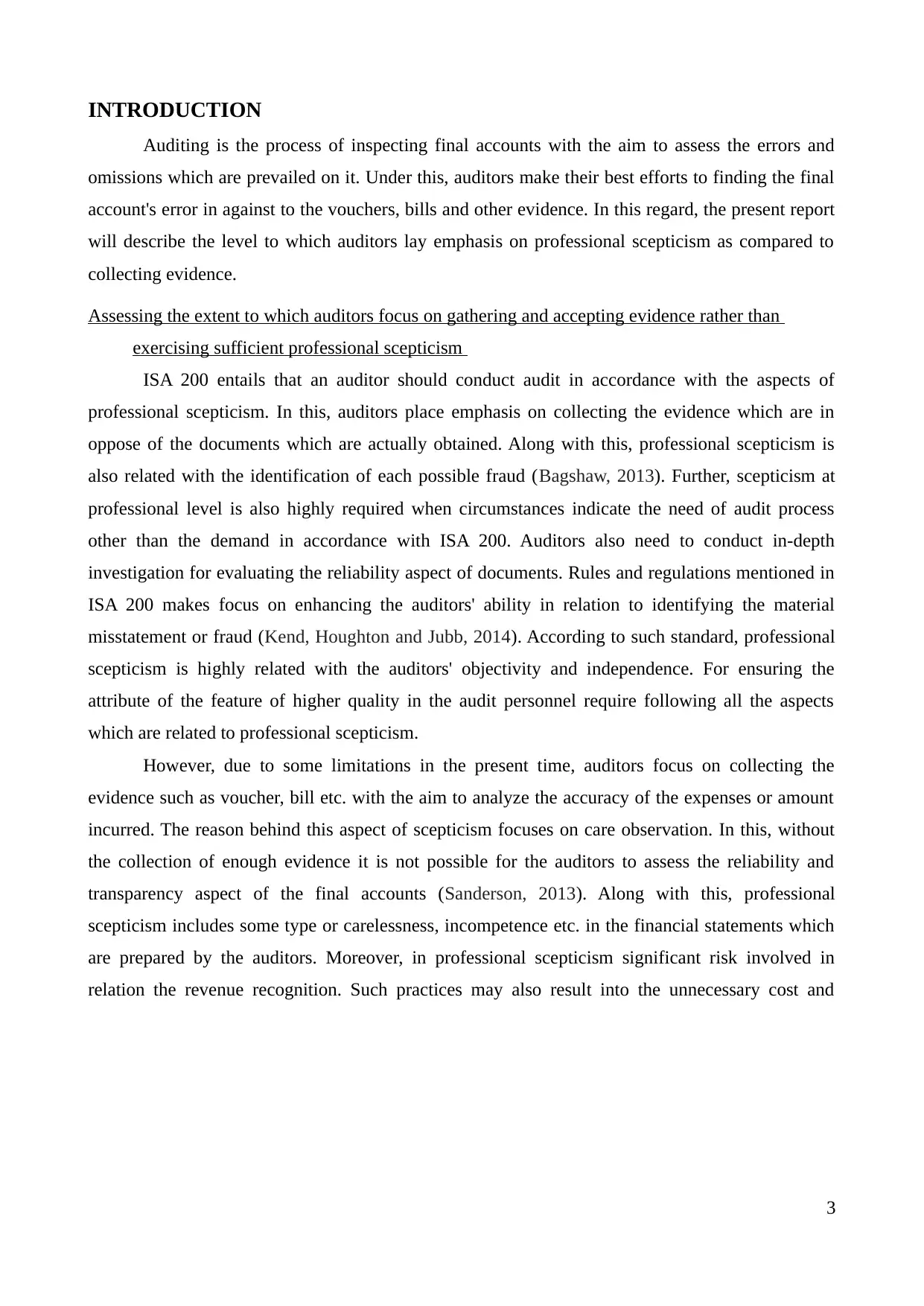
INTRODUCTION
Auditing is the process of inspecting final accounts with the aim to assess the errors and
omissions which are prevailed on it. Under this, auditors make their best efforts to finding the final
account's error in against to the vouchers, bills and other evidence. In this regard, the present report
will describe the level to which auditors lay emphasis on professional scepticism as compared to
collecting evidence.
Assessing the extent to which auditors focus on gathering and accepting evidence rather than
exercising sufficient professional scepticism
ISA 200 entails that an auditor should conduct audit in accordance with the aspects of
professional scepticism. In this, auditors place emphasis on collecting the evidence which are in
oppose of the documents which are actually obtained. Along with this, professional scepticism is
also related with the identification of each possible fraud (Bagshaw, 2013). Further, scepticism at
professional level is also highly required when circumstances indicate the need of audit process
other than the demand in accordance with ISA 200. Auditors also need to conduct in-depth
investigation for evaluating the reliability aspect of documents. Rules and regulations mentioned in
ISA 200 makes focus on enhancing the auditors' ability in relation to identifying the material
misstatement or fraud (Kend, Houghton and Jubb, 2014). According to such standard, professional
scepticism is highly related with the auditors' objectivity and independence. For ensuring the
attribute of the feature of higher quality in the audit personnel require following all the aspects
which are related to professional scepticism.
However, due to some limitations in the present time, auditors focus on collecting the
evidence such as voucher, bill etc. with the aim to analyze the accuracy of the expenses or amount
incurred. The reason behind this aspect of scepticism focuses on care observation. In this, without
the collection of enough evidence it is not possible for the auditors to assess the reliability and
transparency aspect of the final accounts (Sanderson, 2013). Along with this, professional
scepticism includes some type or carelessness, incompetence etc. in the financial statements which
are prepared by the auditors. Moreover, in professional scepticism significant risk involved in
relation the revenue recognition. Such practices may also result into the unnecessary cost and
3
Auditing is the process of inspecting final accounts with the aim to assess the errors and
omissions which are prevailed on it. Under this, auditors make their best efforts to finding the final
account's error in against to the vouchers, bills and other evidence. In this regard, the present report
will describe the level to which auditors lay emphasis on professional scepticism as compared to
collecting evidence.
Assessing the extent to which auditors focus on gathering and accepting evidence rather than
exercising sufficient professional scepticism
ISA 200 entails that an auditor should conduct audit in accordance with the aspects of
professional scepticism. In this, auditors place emphasis on collecting the evidence which are in
oppose of the documents which are actually obtained. Along with this, professional scepticism is
also related with the identification of each possible fraud (Bagshaw, 2013). Further, scepticism at
professional level is also highly required when circumstances indicate the need of audit process
other than the demand in accordance with ISA 200. Auditors also need to conduct in-depth
investigation for evaluating the reliability aspect of documents. Rules and regulations mentioned in
ISA 200 makes focus on enhancing the auditors' ability in relation to identifying the material
misstatement or fraud (Kend, Houghton and Jubb, 2014). According to such standard, professional
scepticism is highly related with the auditors' objectivity and independence. For ensuring the
attribute of the feature of higher quality in the audit personnel require following all the aspects
which are related to professional scepticism.
However, due to some limitations in the present time, auditors focus on collecting the
evidence such as voucher, bill etc. with the aim to analyze the accuracy of the expenses or amount
incurred. The reason behind this aspect of scepticism focuses on care observation. In this, without
the collection of enough evidence it is not possible for the auditors to assess the reliability and
transparency aspect of the final accounts (Sanderson, 2013). Along with this, professional
scepticism includes some type or carelessness, incompetence etc. in the financial statements which
are prepared by the auditors. Moreover, in professional scepticism significant risk involved in
relation the revenue recognition. Such practices may also result into the unnecessary cost and
3
⊘ This is a preview!⊘
Do you want full access?
Subscribe today to unlock all pages.

Trusted by 1+ million students worldwide
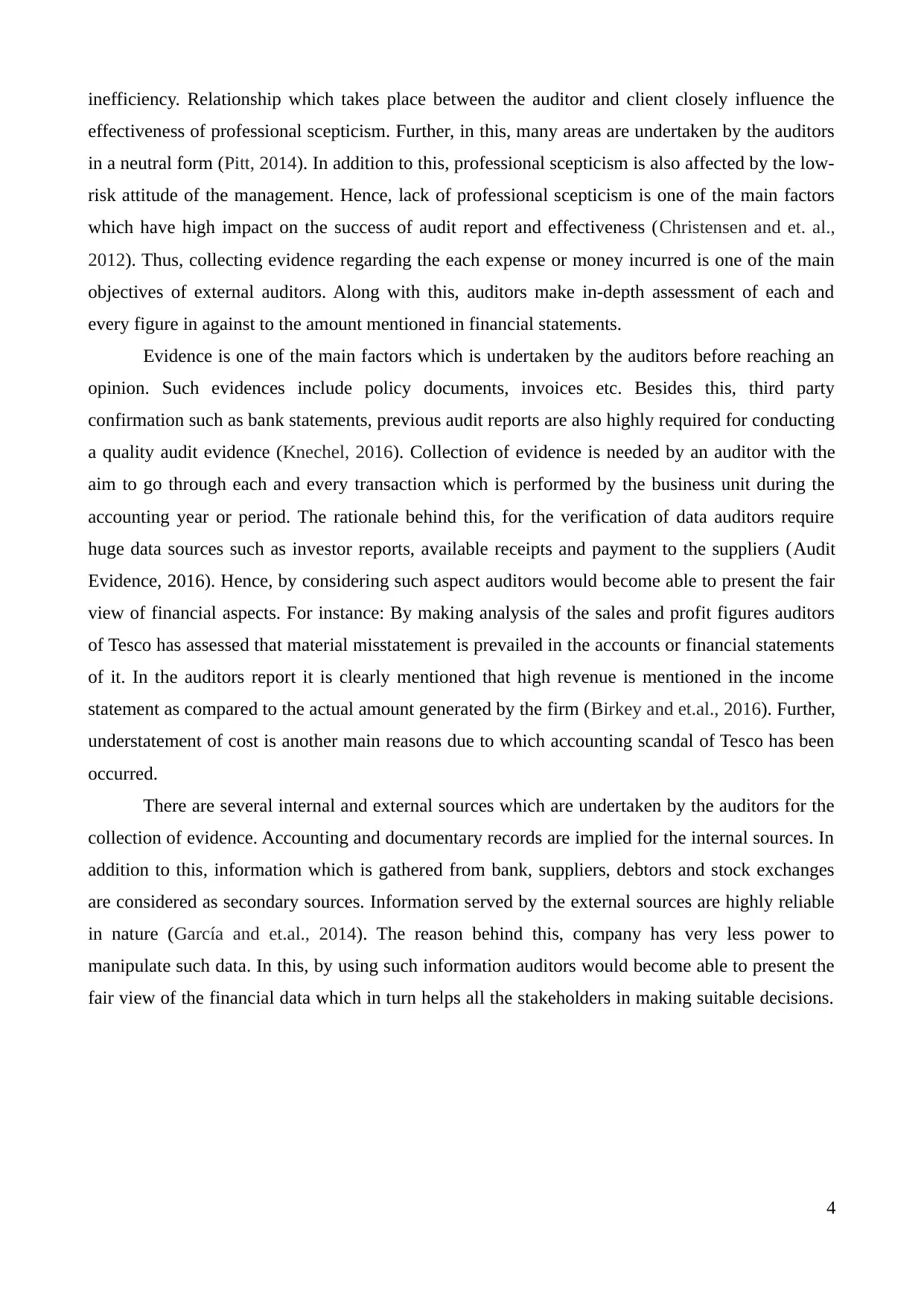
inefficiency. Relationship which takes place between the auditor and client closely influence the
effectiveness of professional scepticism. Further, in this, many areas are undertaken by the auditors
in a neutral form (Pitt, 2014). In addition to this, professional scepticism is also affected by the low-
risk attitude of the management. Hence, lack of professional scepticism is one of the main factors
which have high impact on the success of audit report and effectiveness (Christensen and et. al.,
2012). Thus, collecting evidence regarding the each expense or money incurred is one of the main
objectives of external auditors. Along with this, auditors make in-depth assessment of each and
every figure in against to the amount mentioned in financial statements.
Evidence is one of the main factors which is undertaken by the auditors before reaching an
opinion. Such evidences include policy documents, invoices etc. Besides this, third party
confirmation such as bank statements, previous audit reports are also highly required for conducting
a quality audit evidence (Knechel, 2016). Collection of evidence is needed by an auditor with the
aim to go through each and every transaction which is performed by the business unit during the
accounting year or period. The rationale behind this, for the verification of data auditors require
huge data sources such as investor reports, available receipts and payment to the suppliers (Audit
Evidence, 2016). Hence, by considering such aspect auditors would become able to present the fair
view of financial aspects. For instance: By making analysis of the sales and profit figures auditors
of Tesco has assessed that material misstatement is prevailed in the accounts or financial statements
of it. In the auditors report it is clearly mentioned that high revenue is mentioned in the income
statement as compared to the actual amount generated by the firm (Birkey and et.al., 2016). Further,
understatement of cost is another main reasons due to which accounting scandal of Tesco has been
occurred.
There are several internal and external sources which are undertaken by the auditors for the
collection of evidence. Accounting and documentary records are implied for the internal sources. In
addition to this, information which is gathered from bank, suppliers, debtors and stock exchanges
are considered as secondary sources. Information served by the external sources are highly reliable
in nature (García and et.al., 2014). The reason behind this, company has very less power to
manipulate such data. In this, by using such information auditors would become able to present the
fair view of the financial data which in turn helps all the stakeholders in making suitable decisions.
4
effectiveness of professional scepticism. Further, in this, many areas are undertaken by the auditors
in a neutral form (Pitt, 2014). In addition to this, professional scepticism is also affected by the low-
risk attitude of the management. Hence, lack of professional scepticism is one of the main factors
which have high impact on the success of audit report and effectiveness (Christensen and et. al.,
2012). Thus, collecting evidence regarding the each expense or money incurred is one of the main
objectives of external auditors. Along with this, auditors make in-depth assessment of each and
every figure in against to the amount mentioned in financial statements.
Evidence is one of the main factors which is undertaken by the auditors before reaching an
opinion. Such evidences include policy documents, invoices etc. Besides this, third party
confirmation such as bank statements, previous audit reports are also highly required for conducting
a quality audit evidence (Knechel, 2016). Collection of evidence is needed by an auditor with the
aim to go through each and every transaction which is performed by the business unit during the
accounting year or period. The rationale behind this, for the verification of data auditors require
huge data sources such as investor reports, available receipts and payment to the suppliers (Audit
Evidence, 2016). Hence, by considering such aspect auditors would become able to present the fair
view of financial aspects. For instance: By making analysis of the sales and profit figures auditors
of Tesco has assessed that material misstatement is prevailed in the accounts or financial statements
of it. In the auditors report it is clearly mentioned that high revenue is mentioned in the income
statement as compared to the actual amount generated by the firm (Birkey and et.al., 2016). Further,
understatement of cost is another main reasons due to which accounting scandal of Tesco has been
occurred.
There are several internal and external sources which are undertaken by the auditors for the
collection of evidence. Accounting and documentary records are implied for the internal sources. In
addition to this, information which is gathered from bank, suppliers, debtors and stock exchanges
are considered as secondary sources. Information served by the external sources are highly reliable
in nature (García and et.al., 2014). The reason behind this, company has very less power to
manipulate such data. In this, by using such information auditors would become able to present the
fair view of the financial data which in turn helps all the stakeholders in making suitable decisions.
4
Paraphrase This Document
Need a fresh take? Get an instant paraphrase of this document with our AI Paraphraser
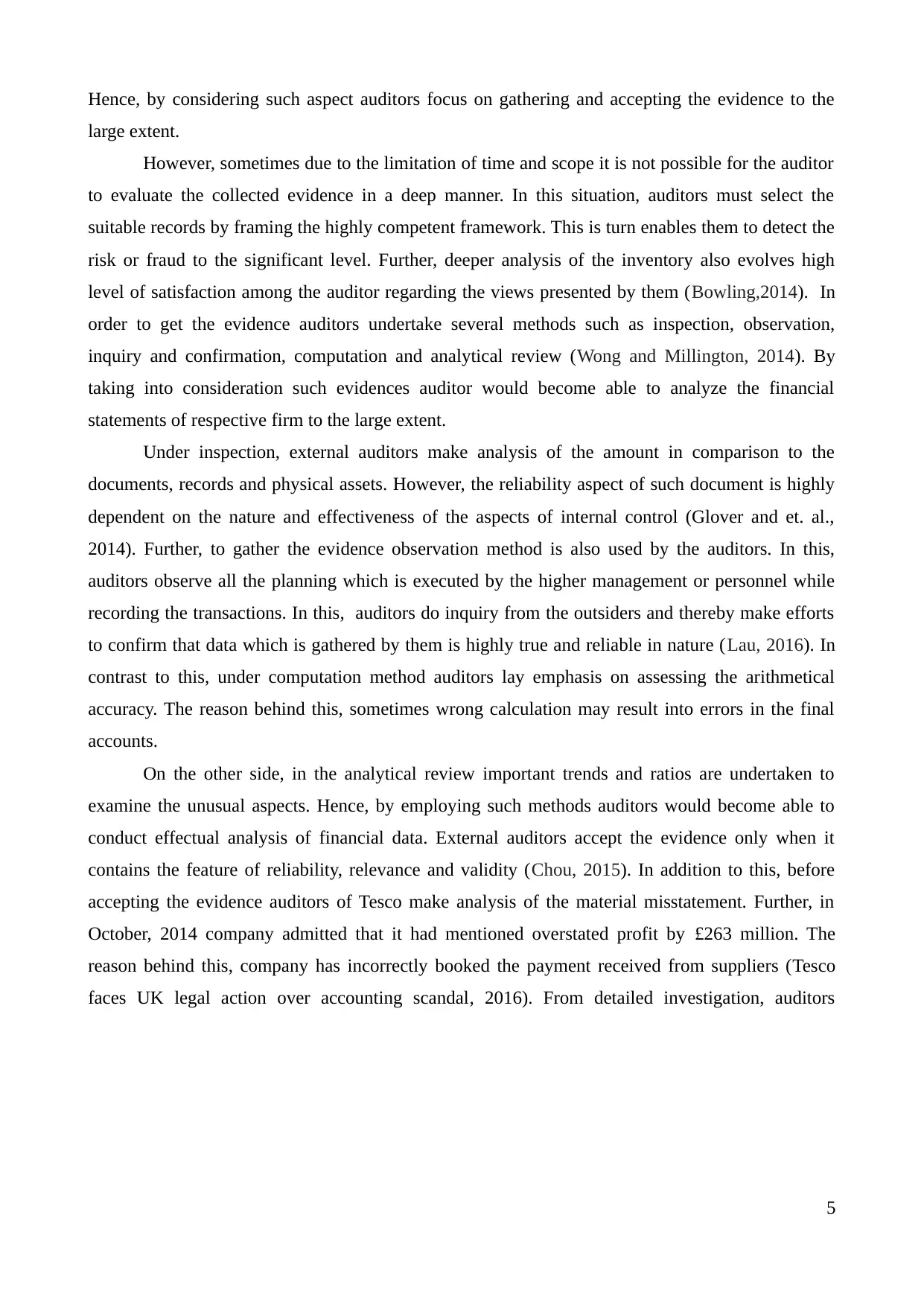
Hence, by considering such aspect auditors focus on gathering and accepting the evidence to the
large extent.
However, sometimes due to the limitation of time and scope it is not possible for the auditor
to evaluate the collected evidence in a deep manner. In this situation, auditors must select the
suitable records by framing the highly competent framework. This is turn enables them to detect the
risk or fraud to the significant level. Further, deeper analysis of the inventory also evolves high
level of satisfaction among the auditor regarding the views presented by them (Bowling,2014). In
order to get the evidence auditors undertake several methods such as inspection, observation,
inquiry and confirmation, computation and analytical review (Wong and Millington, 2014). By
taking into consideration such evidences auditor would become able to analyze the financial
statements of respective firm to the large extent.
Under inspection, external auditors make analysis of the amount in comparison to the
documents, records and physical assets. However, the reliability aspect of such document is highly
dependent on the nature and effectiveness of the aspects of internal control (Glover and et. al.,
2014). Further, to gather the evidence observation method is also used by the auditors. In this,
auditors observe all the planning which is executed by the higher management or personnel while
recording the transactions. In this, auditors do inquiry from the outsiders and thereby make efforts
to confirm that data which is gathered by them is highly true and reliable in nature (Lau, 2016). In
contrast to this, under computation method auditors lay emphasis on assessing the arithmetical
accuracy. The reason behind this, sometimes wrong calculation may result into errors in the final
accounts.
On the other side, in the analytical review important trends and ratios are undertaken to
examine the unusual aspects. Hence, by employing such methods auditors would become able to
conduct effectual analysis of financial data. External auditors accept the evidence only when it
contains the feature of reliability, relevance and validity (Chou, 2015). In addition to this, before
accepting the evidence auditors of Tesco make analysis of the material misstatement. Further, in
October, 2014 company admitted that it had mentioned overstated profit by £263 million. The
reason behind this, company has incorrectly booked the payment received from suppliers (Tesco
faces UK legal action over accounting scandal, 2016). From detailed investigation, auditors
5
large extent.
However, sometimes due to the limitation of time and scope it is not possible for the auditor
to evaluate the collected evidence in a deep manner. In this situation, auditors must select the
suitable records by framing the highly competent framework. This is turn enables them to detect the
risk or fraud to the significant level. Further, deeper analysis of the inventory also evolves high
level of satisfaction among the auditor regarding the views presented by them (Bowling,2014). In
order to get the evidence auditors undertake several methods such as inspection, observation,
inquiry and confirmation, computation and analytical review (Wong and Millington, 2014). By
taking into consideration such evidences auditor would become able to analyze the financial
statements of respective firm to the large extent.
Under inspection, external auditors make analysis of the amount in comparison to the
documents, records and physical assets. However, the reliability aspect of such document is highly
dependent on the nature and effectiveness of the aspects of internal control (Glover and et. al.,
2014). Further, to gather the evidence observation method is also used by the auditors. In this,
auditors observe all the planning which is executed by the higher management or personnel while
recording the transactions. In this, auditors do inquiry from the outsiders and thereby make efforts
to confirm that data which is gathered by them is highly true and reliable in nature (Lau, 2016). In
contrast to this, under computation method auditors lay emphasis on assessing the arithmetical
accuracy. The reason behind this, sometimes wrong calculation may result into errors in the final
accounts.
On the other side, in the analytical review important trends and ratios are undertaken to
examine the unusual aspects. Hence, by employing such methods auditors would become able to
conduct effectual analysis of financial data. External auditors accept the evidence only when it
contains the feature of reliability, relevance and validity (Chou, 2015). In addition to this, before
accepting the evidence auditors of Tesco make analysis of the material misstatement. Further, in
October, 2014 company admitted that it had mentioned overstated profit by £263 million. The
reason behind this, company has incorrectly booked the payment received from suppliers (Tesco
faces UK legal action over accounting scandal, 2016). From detailed investigation, auditors
5
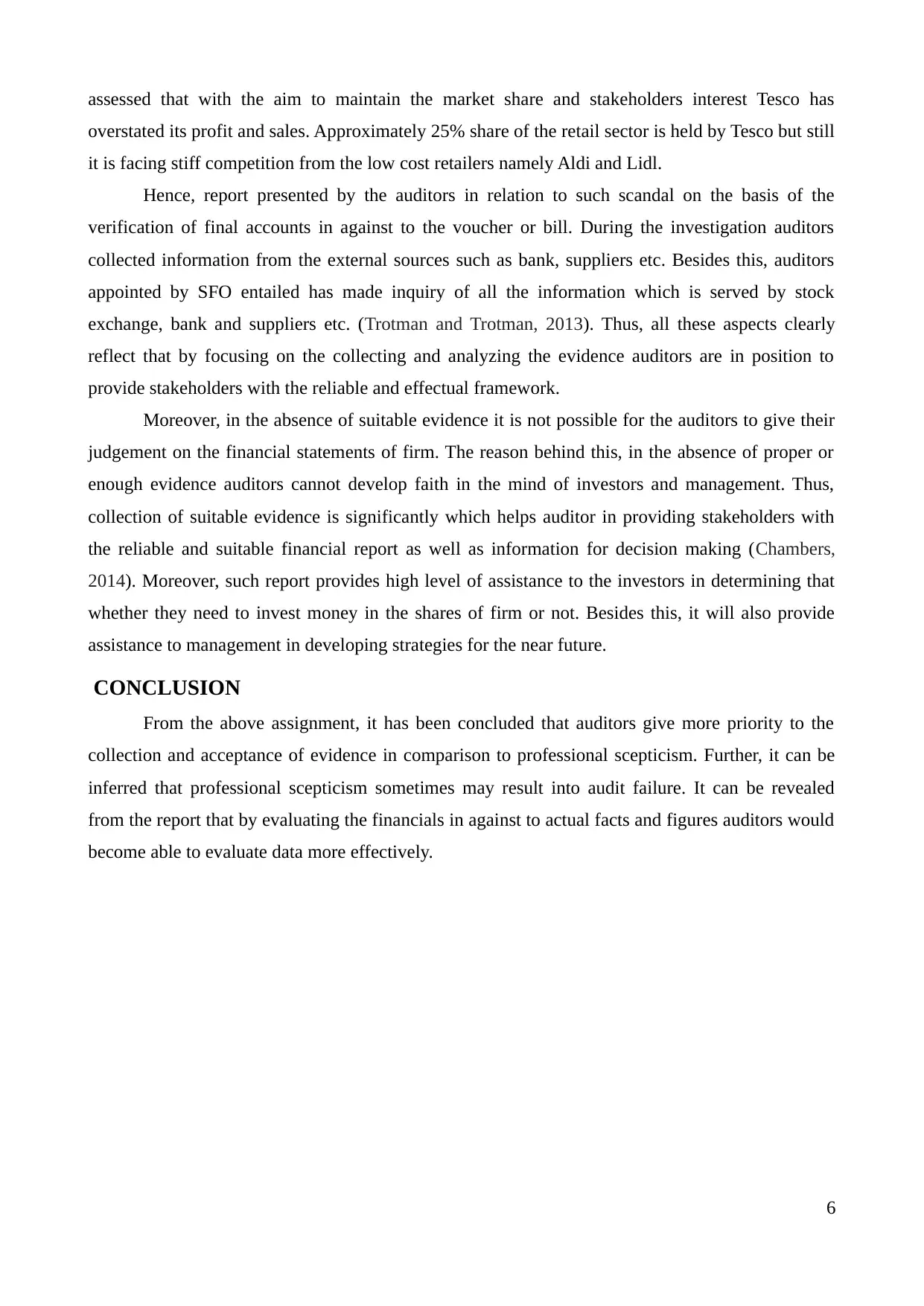
assessed that with the aim to maintain the market share and stakeholders interest Tesco has
overstated its profit and sales. Approximately 25% share of the retail sector is held by Tesco but still
it is facing stiff competition from the low cost retailers namely Aldi and Lidl.
Hence, report presented by the auditors in relation to such scandal on the basis of the
verification of final accounts in against to the voucher or bill. During the investigation auditors
collected information from the external sources such as bank, suppliers etc. Besides this, auditors
appointed by SFO entailed has made inquiry of all the information which is served by stock
exchange, bank and suppliers etc. (Trotman and Trotman, 2013). Thus, all these aspects clearly
reflect that by focusing on the collecting and analyzing the evidence auditors are in position to
provide stakeholders with the reliable and effectual framework.
Moreover, in the absence of suitable evidence it is not possible for the auditors to give their
judgement on the financial statements of firm. The reason behind this, in the absence of proper or
enough evidence auditors cannot develop faith in the mind of investors and management. Thus,
collection of suitable evidence is significantly which helps auditor in providing stakeholders with
the reliable and suitable financial report as well as information for decision making (Chambers,
2014). Moreover, such report provides high level of assistance to the investors in determining that
whether they need to invest money in the shares of firm or not. Besides this, it will also provide
assistance to management in developing strategies for the near future.
CONCLUSION
From the above assignment, it has been concluded that auditors give more priority to the
collection and acceptance of evidence in comparison to professional scepticism. Further, it can be
inferred that professional scepticism sometimes may result into audit failure. It can be revealed
from the report that by evaluating the financials in against to actual facts and figures auditors would
become able to evaluate data more effectively.
6
overstated its profit and sales. Approximately 25% share of the retail sector is held by Tesco but still
it is facing stiff competition from the low cost retailers namely Aldi and Lidl.
Hence, report presented by the auditors in relation to such scandal on the basis of the
verification of final accounts in against to the voucher or bill. During the investigation auditors
collected information from the external sources such as bank, suppliers etc. Besides this, auditors
appointed by SFO entailed has made inquiry of all the information which is served by stock
exchange, bank and suppliers etc. (Trotman and Trotman, 2013). Thus, all these aspects clearly
reflect that by focusing on the collecting and analyzing the evidence auditors are in position to
provide stakeholders with the reliable and effectual framework.
Moreover, in the absence of suitable evidence it is not possible for the auditors to give their
judgement on the financial statements of firm. The reason behind this, in the absence of proper or
enough evidence auditors cannot develop faith in the mind of investors and management. Thus,
collection of suitable evidence is significantly which helps auditor in providing stakeholders with
the reliable and suitable financial report as well as information for decision making (Chambers,
2014). Moreover, such report provides high level of assistance to the investors in determining that
whether they need to invest money in the shares of firm or not. Besides this, it will also provide
assistance to management in developing strategies for the near future.
CONCLUSION
From the above assignment, it has been concluded that auditors give more priority to the
collection and acceptance of evidence in comparison to professional scepticism. Further, it can be
inferred that professional scepticism sometimes may result into audit failure. It can be revealed
from the report that by evaluating the financials in against to actual facts and figures auditors would
become able to evaluate data more effectively.
6
⊘ This is a preview!⊘
Do you want full access?
Subscribe today to unlock all pages.

Trusted by 1+ million students worldwide
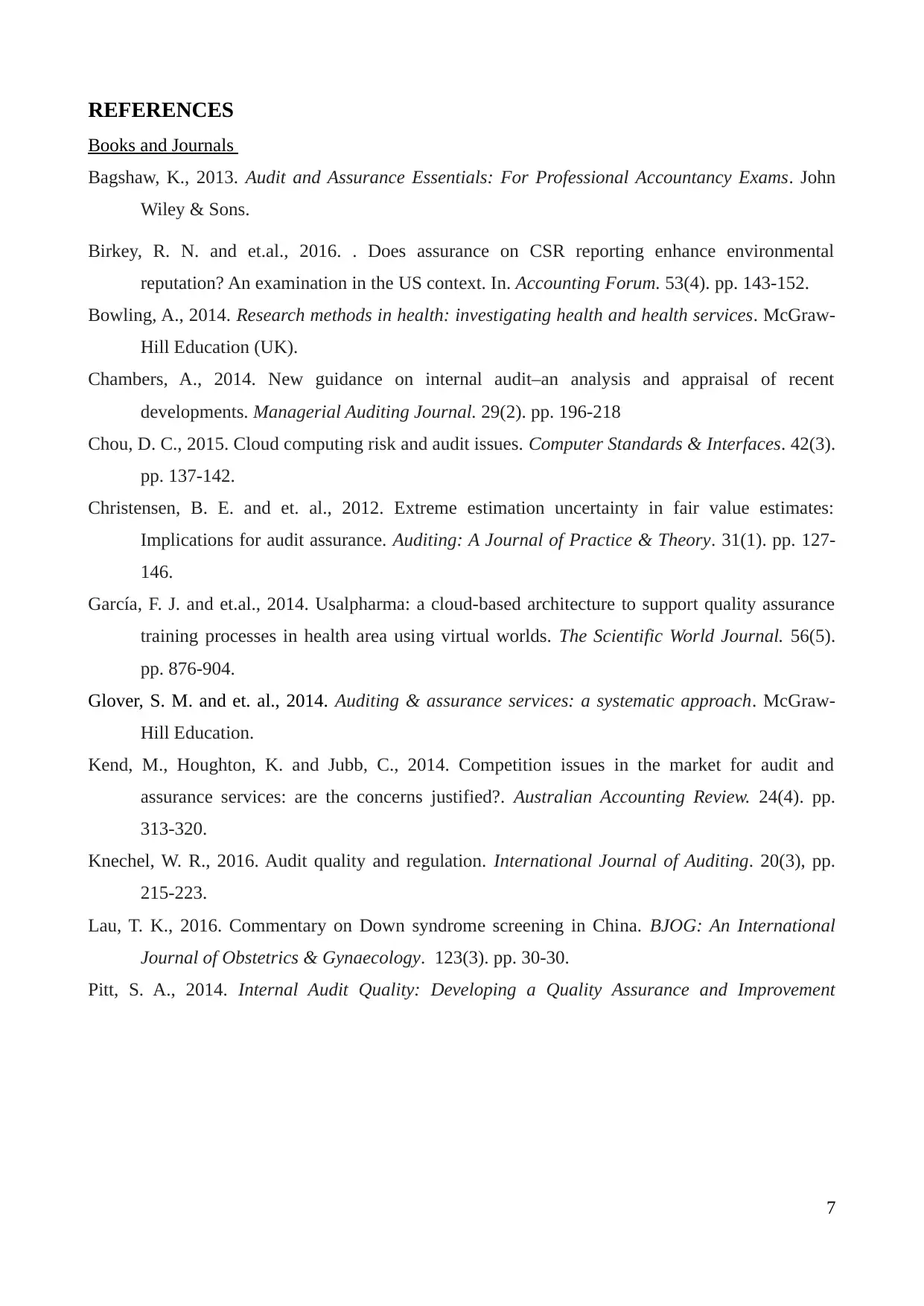
REFERENCES
Books and Journals
Bagshaw, K., 2013. Audit and Assurance Essentials: For Professional Accountancy Exams. John
Wiley & Sons.
Birkey, R. N. and et.al., 2016. . Does assurance on CSR reporting enhance environmental
reputation? An examination in the US context. In. Accounting Forum. 53(4). pp. 143-152.
Bowling, A., 2014. Research methods in health: investigating health and health services. McGraw-
Hill Education (UK).
Chambers, A., 2014. New guidance on internal audit–an analysis and appraisal of recent
developments. Managerial Auditing Journal. 29(2). pp. 196-218
Chou, D. C., 2015. Cloud computing risk and audit issues. Computer Standards & Interfaces. 42(3).
pp. 137-142.
Christensen, B. E. and et. al., 2012. Extreme estimation uncertainty in fair value estimates:
Implications for audit assurance. Auditing: A Journal of Practice & Theory. 31(1). pp. 127-
146.
García, F. J. and et.al., 2014. Usalpharma: a cloud-based architecture to support quality assurance
training processes in health area using virtual worlds. The Scientific World Journal. 56(5).
pp. 876-904.
Glover, S. M. and et. al., 2014. Auditing & assurance services: a systematic approach. McGraw-
Hill Education.
Kend, M., Houghton, K. and Jubb, C., 2014. Competition issues in the market for audit and
assurance services: are the concerns justified?. Australian Accounting Review. 24(4). pp.
313-320.
Knechel, W. R., 2016. Audit quality and regulation. International Journal of Auditing. 20(3), pp.
215-223.
Lau, T. K., 2016. Commentary on Down syndrome screening in China. BJOG: An International
Journal of Obstetrics & Gynaecology. 123(3). pp. 30-30.
Pitt, S. A., 2014. Internal Audit Quality: Developing a Quality Assurance and Improvement
7
Books and Journals
Bagshaw, K., 2013. Audit and Assurance Essentials: For Professional Accountancy Exams. John
Wiley & Sons.
Birkey, R. N. and et.al., 2016. . Does assurance on CSR reporting enhance environmental
reputation? An examination in the US context. In. Accounting Forum. 53(4). pp. 143-152.
Bowling, A., 2014. Research methods in health: investigating health and health services. McGraw-
Hill Education (UK).
Chambers, A., 2014. New guidance on internal audit–an analysis and appraisal of recent
developments. Managerial Auditing Journal. 29(2). pp. 196-218
Chou, D. C., 2015. Cloud computing risk and audit issues. Computer Standards & Interfaces. 42(3).
pp. 137-142.
Christensen, B. E. and et. al., 2012. Extreme estimation uncertainty in fair value estimates:
Implications for audit assurance. Auditing: A Journal of Practice & Theory. 31(1). pp. 127-
146.
García, F. J. and et.al., 2014. Usalpharma: a cloud-based architecture to support quality assurance
training processes in health area using virtual worlds. The Scientific World Journal. 56(5).
pp. 876-904.
Glover, S. M. and et. al., 2014. Auditing & assurance services: a systematic approach. McGraw-
Hill Education.
Kend, M., Houghton, K. and Jubb, C., 2014. Competition issues in the market for audit and
assurance services: are the concerns justified?. Australian Accounting Review. 24(4). pp.
313-320.
Knechel, W. R., 2016. Audit quality and regulation. International Journal of Auditing. 20(3), pp.
215-223.
Lau, T. K., 2016. Commentary on Down syndrome screening in China. BJOG: An International
Journal of Obstetrics & Gynaecology. 123(3). pp. 30-30.
Pitt, S. A., 2014. Internal Audit Quality: Developing a Quality Assurance and Improvement
7
Paraphrase This Document
Need a fresh take? Get an instant paraphrase of this document with our AI Paraphraser
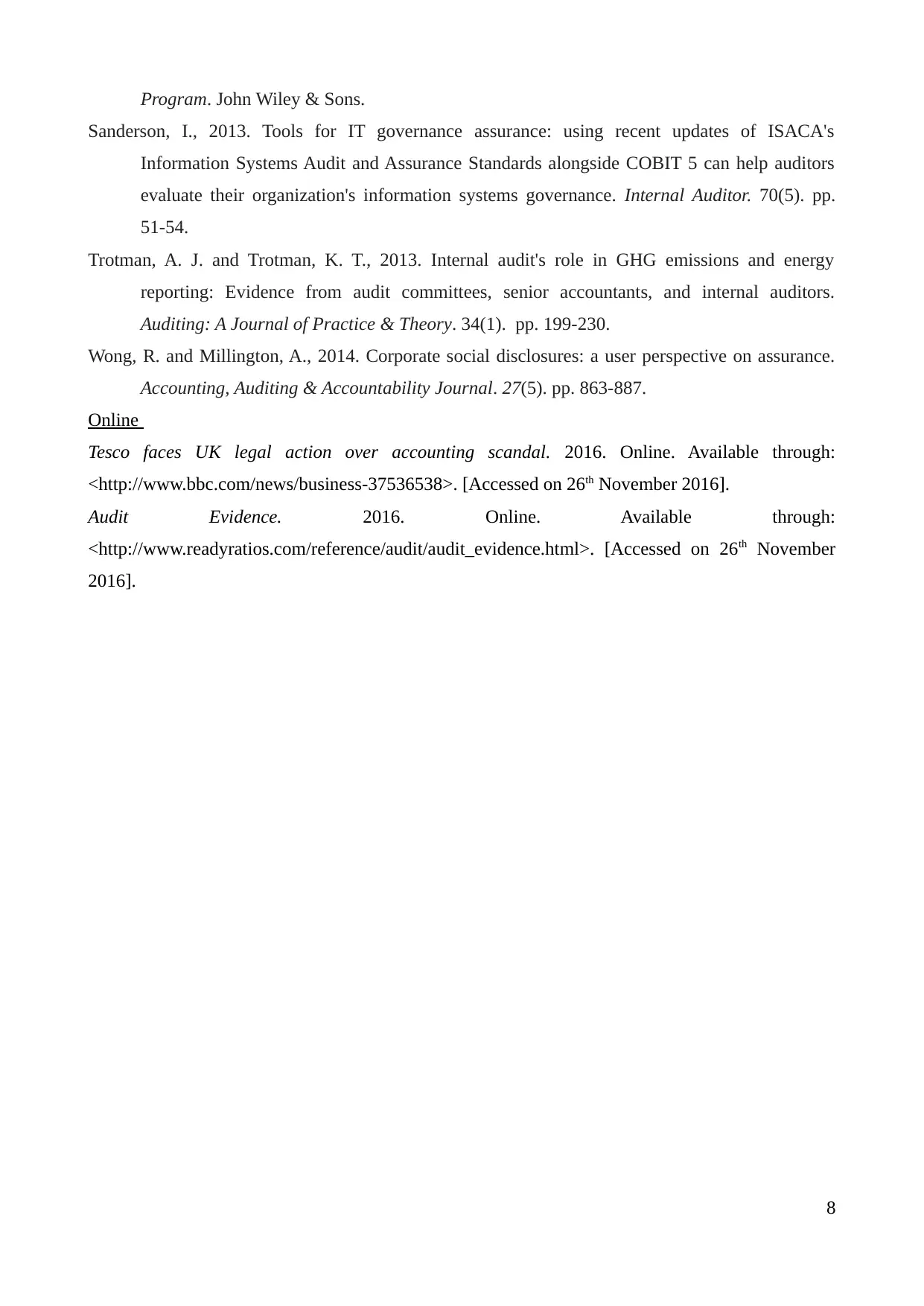
Program. John Wiley & Sons.
Sanderson, I., 2013. Tools for IT governance assurance: using recent updates of ISACA's
Information Systems Audit and Assurance Standards alongside COBIT 5 can help auditors
evaluate their organization's information systems governance. Internal Auditor. 70(5). pp.
51-54.
Trotman, A. J. and Trotman, K. T., 2013. Internal audit's role in GHG emissions and energy
reporting: Evidence from audit committees, senior accountants, and internal auditors.
Auditing: A Journal of Practice & Theory. 34(1). pp. 199-230.
Wong, R. and Millington, A., 2014. Corporate social disclosures: a user perspective on assurance.
Accounting, Auditing & Accountability Journal. 27(5). pp. 863-887.
Online
Tesco faces UK legal action over accounting scandal. 2016. Online. Available through:
<http://www.bbc.com/news/business-37536538>. [Accessed on 26th November 2016].
Audit Evidence. 2016. Online. Available through:
<http://www.readyratios.com/reference/audit/audit_evidence.html>. [Accessed on 26th November
2016].
8
Sanderson, I., 2013. Tools for IT governance assurance: using recent updates of ISACA's
Information Systems Audit and Assurance Standards alongside COBIT 5 can help auditors
evaluate their organization's information systems governance. Internal Auditor. 70(5). pp.
51-54.
Trotman, A. J. and Trotman, K. T., 2013. Internal audit's role in GHG emissions and energy
reporting: Evidence from audit committees, senior accountants, and internal auditors.
Auditing: A Journal of Practice & Theory. 34(1). pp. 199-230.
Wong, R. and Millington, A., 2014. Corporate social disclosures: a user perspective on assurance.
Accounting, Auditing & Accountability Journal. 27(5). pp. 863-887.
Online
Tesco faces UK legal action over accounting scandal. 2016. Online. Available through:
<http://www.bbc.com/news/business-37536538>. [Accessed on 26th November 2016].
Audit Evidence. 2016. Online. Available through:
<http://www.readyratios.com/reference/audit/audit_evidence.html>. [Accessed on 26th November
2016].
8
1 out of 8
Related Documents
Your All-in-One AI-Powered Toolkit for Academic Success.
+13062052269
info@desklib.com
Available 24*7 on WhatsApp / Email
![[object Object]](/_next/static/media/star-bottom.7253800d.svg)
Unlock your academic potential
Copyright © 2020–2025 A2Z Services. All Rights Reserved. Developed and managed by ZUCOL.





